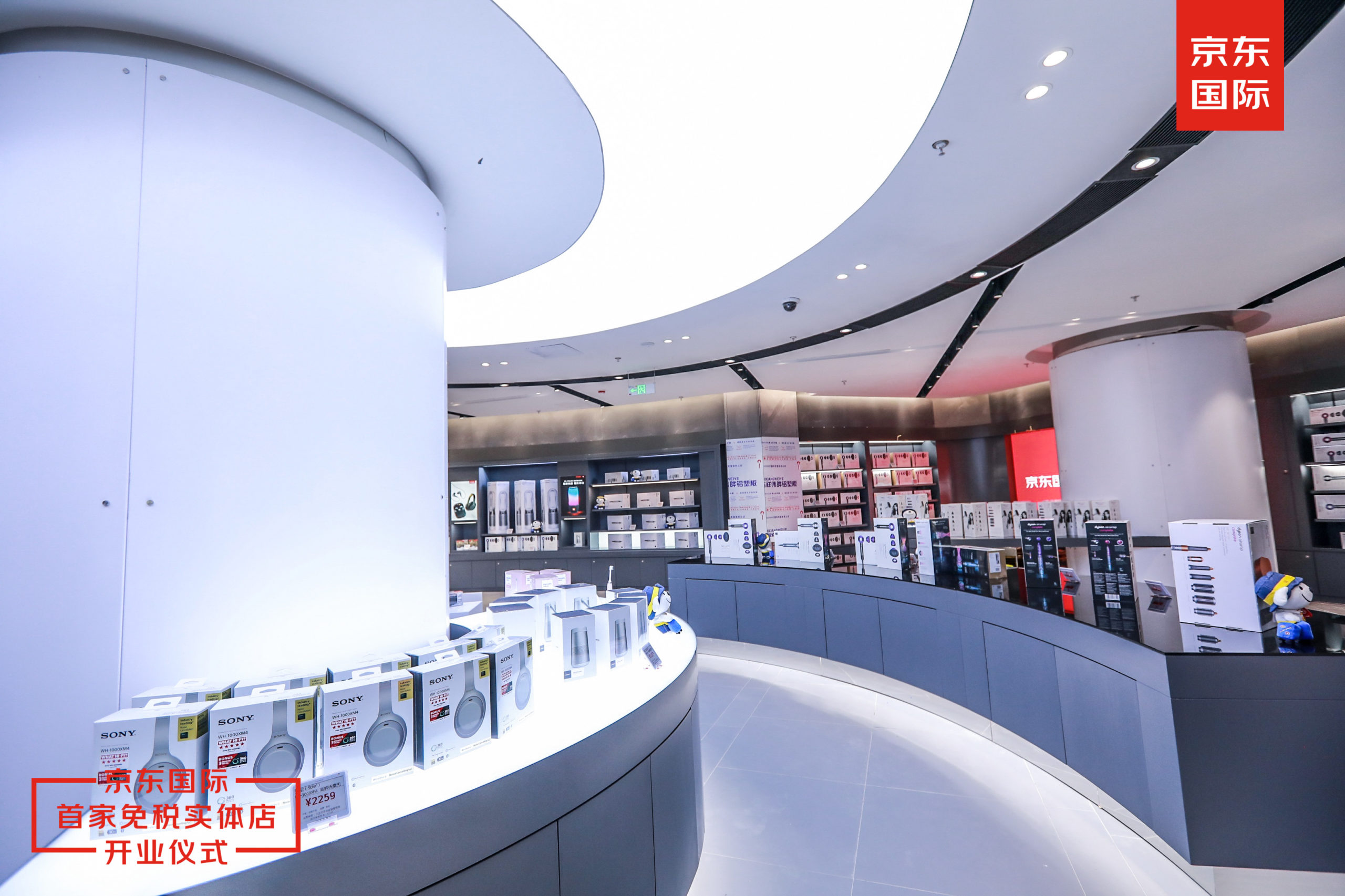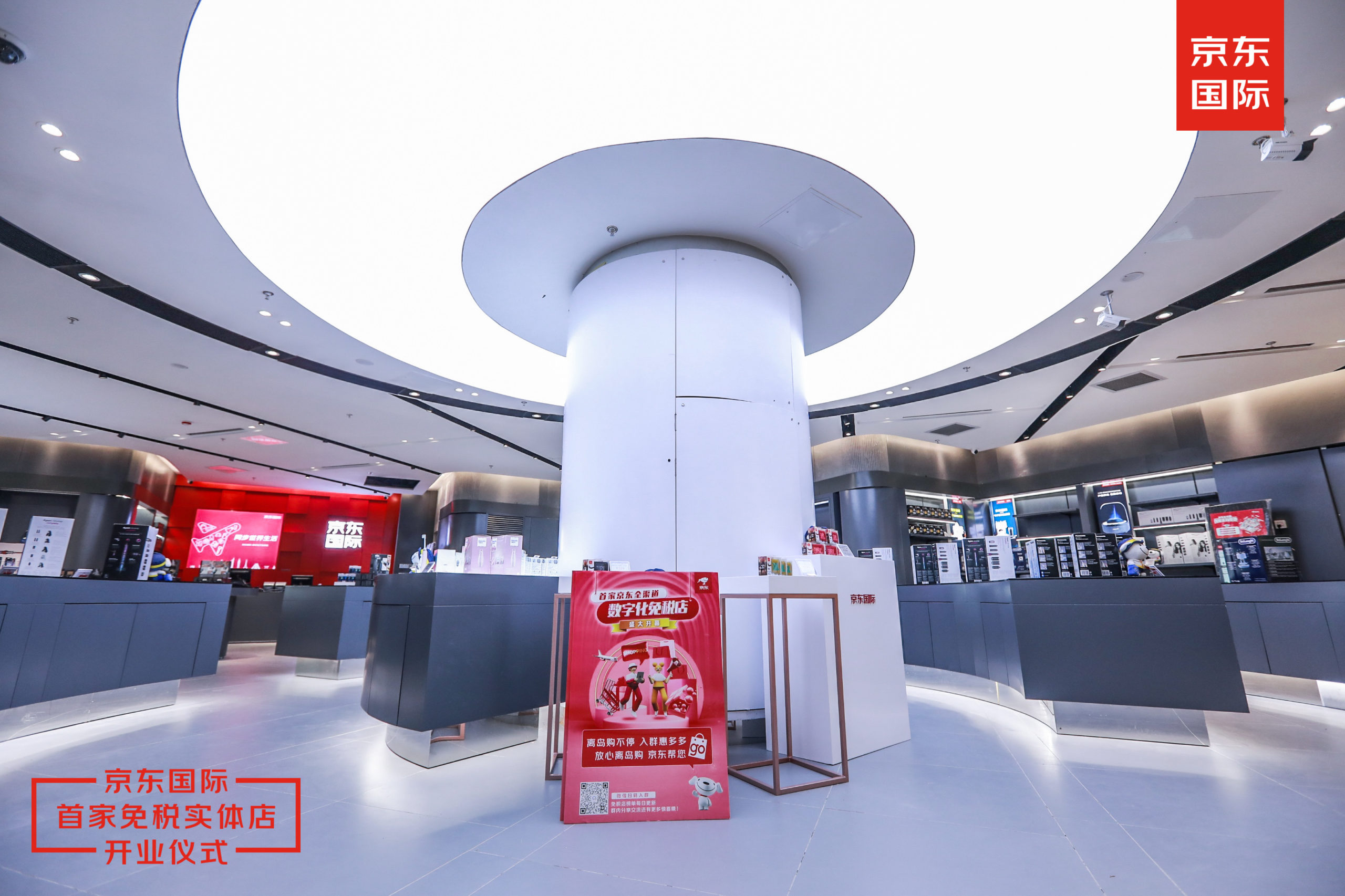Jan 11, 2021|
In-depth Report: JD’s Foray Into Duty Free: Bring In More Players, Add Categories, Sell O2O
by Ella Kidron, Ling Cao, Rachel Liu
JD made its move into the duty free industry by opening a store through partnering with Hainan Tourism and Investment Development Co. in Sanya, Hainan province on Dec. 30, 2020. The store, which is located on the second floor of the Sanya Hailv Duty Free Shopping Center, came just in time to service consumers during the past New Year’s Day holiday. Data from Haikou’s Customs showed that during January 1st to 3rd, sales from three newly opened duty free shopping centers, including Sanya Hailv, reached RMB 540 million yuan, an increase of 195% YOY, hitting a historical record.
Unique characteristics, a more diverse customer base
JD has leveraged its expertise in e-commerce, marketing and supply chain to create a store that is unlike traditional duty free stores. Whereas most duty free shops focus on fashion, luxury, cosmetics, and even alcohol and cigarettes, JD has gone in an entirely different direction, equipping the store with consumer electronics and small appliances, such as hair dryers, speakers, and coffee machines. In this way, leveraging its advantage of a long track record as the e-commerce destination for consumer electronics, JD aims to provide consumers with a wider range of affordable products than was available previously and attract a larger variety of consumers to duty free shopping.
To provide an even more robust product selection, JD has also launched a cross border experience store on the fourth floor of the same shopping center in Hainan with a focus on selling healthcare products, baby and maternal products, and more. Ahead of the New Year’s Day holiday period, JD used big data to forecast demand before recommending what to stock in the store. During the holiday, healthcare products were among the most popular categories.
Both stores integrate JD’s cloud & AI technology, as well as omnichannel capabilities, in order to provide an upgraded shopping experience for customers. The stores include features such as smart shelves, allowing customers to scan QR codes and shop for products online, electronic price tags which ensure real-time price adjustment, and smart marketing devices.
China’s RMB 150 billion “blue ocean”
Before the global outbreak of COVID-19, travel retail was already set to take off in China. Many brands have been starting to focus more on this as a priority business segment and are developing the channel accordingly. But, despite consumers’ fondness for buying premium goods at duty-free stores, the market at large is largely undeveloped. According to statistics from Morgan Stanley, China represents just 8% of the global duty-free market, but its consumers accounted for a third of global duty-free sales in 2018.
With overseas flights grounded on account of COVID-19, spending abroad is moving onshore instead. The Chinese government has implemented a series of policies in this area. Since Jul. 1,2020, Hainan province increased the annual tax-free quota from RMB 30,000 yuan to RMB 100,000 yuan per person per year, and expanded tax-free categories from 38-to-45, including electronics products and wine.
At the same time, in early June, China released a plan to build a high-quality free trade port in the province. According to the plan, Hainan will establish a basic free trade port policy system with a key focus on helping free trade and investment by 2025. The combined preferential policies from the consumer and business side bode well for the development of the sector.
Analysts at Berstein expect China’s domestic duty-free sales to be worth RMB 153 billion yuan in 2025, roughly $23 billion at the current exchange rate level, tripling the current level. This is still just a fraction of the global duty-free market, which is estimated to generate revenues of around $112 billion by 2023, growing at a CAGR of approximately 8% during 2018-2023. “During the epidemic, Hainan’s duty-free stores were the biggest change in China’s duty-free landscape. In July 2020, Haikou established a duty-free store. One month after the implementation of the new policy for duty-free shopping on outlying islands, there was a total of RMB 2.219 billion yuan worth of duty-free shopping there”, explained Ashley Duardonek, Founder of Alarice and ChoZan.
Duardonek added that Bain & Company has predicted that global travel is unlikely to return to normal by 2022 or even 2023 and that the Chinese luxury market will grow about 30% in 2021. “This means there’s still a 2-3 year window of growth for Hainan’s duty-free market, and the government is sparing no effort to boost domestic demand.”
With such a high potential market, and a long growth trajectory, many companies are interested in getting in on the action. JD’s supply chain advantages give the company a unique position to provide consumers new value. This is one of the many reasons the company is focused on building out this segment. “Unlike the international market, which is quite developed, the domestic market is still in early stages,” said Mark Ma, head of operations for JD’s duty-free business at JD Worldwide. “At the same time, the duty free channel has become more important to brands in recent years. These are just a few of the reasons that JD wants to enter and build out our footprint in this industry. We believe we can leverage our strengths to provide differentiated services for a more expansive range of customers, helping brands and the industry in the process.”
An ecosystem, Win-Win approach
By moving into the duty-free business, JD can benefit brands and traditional industry players with supply chain capability and digital tools. For one, the company can help brands that are not familiar with the duty free industry get started. According to research by Industrial Securities, during July to October 2020, makeup accounted for 48% of total sales of offshore duty-free products in Hainan province, while watches accounted for 14.7% and accessories were 15.4%. The categories of duty-free products are very limited. Although customers have demand for more diversified duty-free products, many brands do not have the ability or resources to get into the business. This is where JD’s experience in logistics and finance, as well as its close partnership with international brands can help.
“For brands, more involved in the duty-free business also means more control over the product price and channels on this market, thus increasing regulation in the industry. We hope that more brands, especially those that are not traditionally popular in the duty-free space, such as electronics brands, can work with JD to explore the market.” said Di He, head of supply chain for JD’s duty free program.
JD’s industry insights can also help brands identify new opportunities. In JD’s cross-border experience store, health-supplements became a popular category among elderly customers. Many elderly people travel to Sanya every winter to enjoy the warmth. JD noticed that most of them are not interested in buying makeup or luxury products no matter how competitive the prices are. However, they do have strong demand for health supplements and health related products. Adding health-related categories into the stores not only benefits elderly customers in Sanya, but also provides a new sales opportunity for brands. In the first five days, sales of health-related products accounted for 50% of the store’s total sales.
JD’s participation will also help traditional duty-free players address common challenges. In China, the government-approved duty free operators mostly focus on operating offline stores. JD’s know-how in e-commerce and online operations can help the stores with digital transformation.
Take customer operations for example. Customers of duty-free stores are usually travelers, which means they are not likely to revisit the stores frequently. JD’s digitalization capabilities can help the stores move customers online and use LBS (Location Based Service), targeted advertisements and more to increase customer loyalty and activity. In addition, JD’s store management tools, such as electronic price tags, smart advertisement boards, and customer road maps, will bring customers a better in-store shopping experience.
“With the policy changes for duty-free in Hainan, both customers and industry players demand new experiences and opportunities. Instead of competing with existing duty-free companies, JD’s participation can not only serve to supplement traditional product categories for the industry, but also introduce an omnichannel experience, and make the industry more standardized and efficient.” said Mark Ma.
One of the drivers of efficiency and experience for the duty free market will be the introduction of advanced technology like 5G, IoT and big data on a largely traditional industry. Many duty free operators are thinking about how to go digital. This is a key consideration for industry players to increase their efficiency as they achieve scale.
Ma said, “Going forward, I think more and more customers will lean towards pre-ordering products online. Leveraging JD’s experience, we will work together with local partners to provide an integrated omnichannel solution for customers.” Ma explained that the boundary between online and offline will be blurred, increasing the necessity for JD and industry partners to build a platform that can allow customers to buy products whenever and wherever they want. Duardonek notes that “this is convenient, fast and in line with standard Chinese consumption habits.”
Duty free has a long and promising road ahead and JD is optimistic about the industry’s potential. “We plan to work with more stores in more scenarios, such as airports, in the future” Ma added.









 This Harbin tourism boom has also spurred a surge in sales of winter apparel. JD.com’s data indicates a rapid growth in the sales of warm clothing items such as down jackets, snow boots, and thermal underwear between January 1st and 7th. The sales growth is especially pronounced in southern provinces and cities such as Jiangsu, Zhejiang, Guangdong, Sichuan, and Shanghai. Notably, tall snow boots registered a 206% year-on-year increase in transactions, while padded cotton caps and thickened long down jackets soared by 158% and 134%, respectively. Beyond clothing, travel gear has also seen a considerable uptick, with a 98% year-on-year growth in transactions for large suitcases and travel backpacks in these southern regions.
This Harbin tourism boom has also spurred a surge in sales of winter apparel. JD.com’s data indicates a rapid growth in the sales of warm clothing items such as down jackets, snow boots, and thermal underwear between January 1st and 7th. The sales growth is especially pronounced in southern provinces and cities such as Jiangsu, Zhejiang, Guangdong, Sichuan, and Shanghai. Notably, tall snow boots registered a 206% year-on-year increase in transactions, while padded cotton caps and thickened long down jackets soared by 158% and 134%, respectively. Beyond clothing, travel gear has also seen a considerable uptick, with a 98% year-on-year growth in transactions for large suitcases and travel backpacks in these southern regions. JD Eases Gift Procurement before Spring Festival
JD Eases Gift Procurement before Spring Festival



